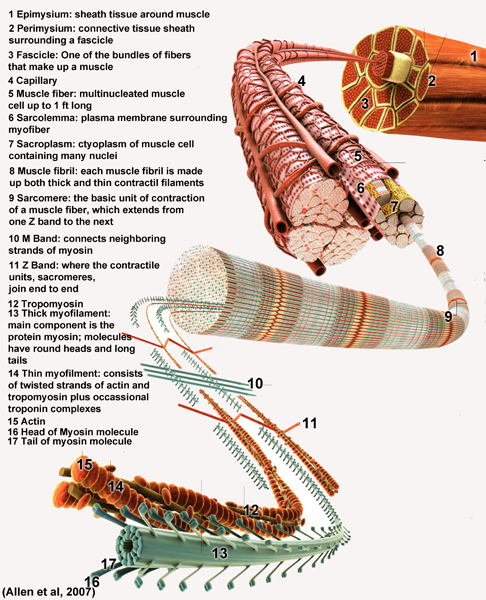How Muscles Work
 When your muscle is relaxed, the myofilaments are only partially overlapped. Once an impulse is set to contract the muscle, the myosin filaments slide between your actin filaments to shorten the myofibril and muscle fiber (Allen et al, 2007). Your brain can monitor the tension of your muscles using what's called the neuromuscular spindle. Muscles contain tiny sensors that are wrapped around the muscle fibers, these sensors are what relay information to your brain about your current position, posture, and comfort. This is typically referred to as proprioception
When your muscle is relaxed, the myofilaments are only partially overlapped. Once an impulse is set to contract the muscle, the myosin filaments slide between your actin filaments to shorten the myofibril and muscle fiber (Allen et al, 2007). Your brain can monitor the tension of your muscles using what's called the neuromuscular spindle. Muscles contain tiny sensors that are wrapped around the muscle fibers, these sensors are what relay information to your brain about your current position, posture, and comfort. This is typically referred to as proprioception
So Why do Tendons Matter?

If you have ever pulled a tendon, you will know that tendons matter in muscle function. They are the tough, fibrous connective tissue that attaches your muscles to your bones (Allen et al, 2007). Without tendons, you would be unable to move and manipulate your body. Tendons are comprised of millions of collegan proteins, water, and tenocytes that are woven together. The tendon grows right into the bone causing a permanent bond that is highly durable and extremely difficult to break (Wise Geek, 2003). Despite their structure suggesting strength, tendons must be properly cared for or else they become damaged or overstrained. Damage to your tendons occurs most commonly when overuse causes the collagen fibers to develop small tears, this condition is called tendonitis (Wise Geek, 2003).

Article References
Ackerley, S. K. (n.d.). Muscle Tissue. Retrieved 10 21, 2011, from Developmental Biology Online: http://www.uoguelph.ca/zoology/devobio/210labs/muscle1.html
Allen, M., Bagg, A., Hamilton, J., John, K., Fricker, J., de Burgh, J., et al. (2007). The Human Body Book. New York: DK Publishing.
Mackenzie, B. (1999). Muscle Types. Retrieved 10 21, 2011, from BrianMac: http://www.brianmac.co.uk/muscle.htm
The Nemours Foundation. (1995). Your Muscles. Retrieved 10 21, 2011, from Kid's Health: http://kidshealth.org/kid/htbw/muscles.html
Wise Geek. (2003). What are Tendons. Retrieved 10 21, 2011, from Wise Geek: http://www.wisegeek.com/what-are-tendons.htm
Image References
Someone else's art deserves recognition! The images presented in this article were borrowed from the following places:
Header Image: http://modernhealthandfitness.com/wp-content/uploads/2011/12/muscles-anatomy-back.jpg | Retrieved April 26, 2015
Image 1: Allen, M., Bagg, A., Hamilton, J., John, K., Fricker, J., de Burgh, J., et al. (2007). The Human Body Book. New York: DK Publishing.
Image 2: Allen, M., Bagg, A., Hamilton, J., John, K., Fricker, J., de Burgh, J., et al. (2007). The Human Body Book. New York: DK Publishing.
Image 3: Allen, M., Bagg, A., Hamilton, J., John, K., Fricker, J., de Burgh, J., et al. (2007). The Human Body Book. New York: DK Publishing.